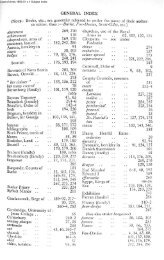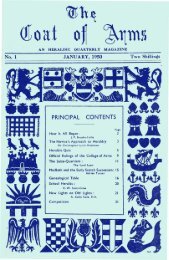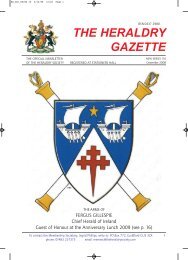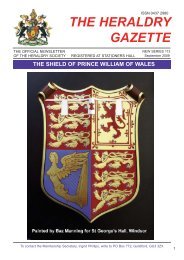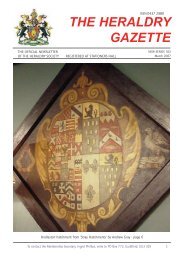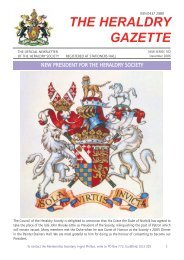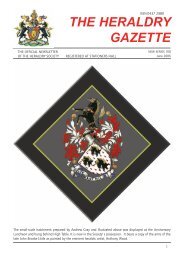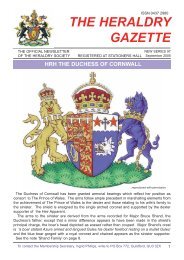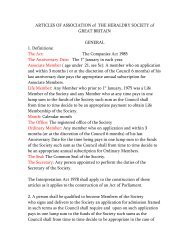Mrs. Leslie Holt's - The Heraldry Society
Mrs. Leslie Holt's - The Heraldry Society
Mrs. Leslie Holt's - The Heraldry Society
Create successful ePaper yourself
Turn your PDF publications into a flip-book with our unique Google optimized e-Paper software.
Correspondence<br />
Economy is not Economics<br />
John W Mitchell (Dec 2010) takes<br />
me to task for claiming “I think I am<br />
correct in saying that pure economics<br />
has never been seen on a coat of arms<br />
before” my own. He asks if the use of<br />
‘Economia’ by the Institute of Chartered<br />
Accountants (ICAEW) counts and<br />
the editor responds “it certainly<br />
does”. Let me thank Mr Mitchell for<br />
his question and please allow me<br />
to disagree totally with our editor.<br />
First I asked myself why on earth<br />
would a group of accountants want<br />
to use economics as the dominant<br />
theme of its coat of arms. <strong>The</strong> two<br />
disciplines are not related at all and<br />
this struck me as a bizarre notion.<br />
Second I visited the ICAEW web<br />
site which is very helpful. It claims<br />
the lady featured was chosen by the<br />
Heralds in 1880 and would appear<br />
to be Economia as in the image in<br />
Iconologia by Cesare Ripa (1603).<br />
It goes on to report that in 1948<br />
ICAEW Librarian Cosmo Gordon<br />
wrote of the lady: “<strong>The</strong> rod signifies<br />
command, the rudder guidance; with<br />
the divders she measures her powers<br />
and so she estimates what she has to<br />
spend.” Elsewhere she is described<br />
as “female figure proper representing<br />
Economy.” One reason the web site is<br />
so helpful is that so many accountants<br />
are confused by her I suspect.<br />
Third I visited a web-hosted English<br />
translation of Iconologia and on page<br />
26 found Economia (so helpfuly<br />
translated as Oeconomy) described<br />
and then interpreted with modern<br />
spelling as follows: “<strong>The</strong> stick denotes<br />
the rule a master has over his house;<br />
the rudder the care a father ought<br />
to have over his children. <strong>The</strong> olive<br />
garland, the pains he is to take in<br />
maintaining peace in his family; the<br />
rudder, prudence, and moderation.”<br />
I struggle to see any relevance to either<br />
accounting or pure economics in that<br />
and wonder why the Heralds 130 years<br />
ago chose her for the accountants.<br />
<strong>The</strong>re is a hint in all of this of<br />
economy in the sense of good<br />
handling or management, the sort<br />
of things young ladies were taught<br />
in the past in order that they could<br />
prudently rule the domestic sphere<br />
HERALDRY GAZETTE<br />
- household accounts maybe but<br />
certainly not a jot of economic theory.<br />
In the same article I was also quoted<br />
as saying that I wanted to avoid coins<br />
and the like on my arms because to me<br />
they represent banking and finance,<br />
not economics. Funnily enough when<br />
you put Economia into a search engine<br />
you can find a set of images and every<br />
single one of them is tied to money.<br />
Economics is not about accounting,<br />
household accounts, money, banking<br />
or finance. Rather it about how we<br />
allocate scarce resources and I stand<br />
by my claim that my coat of arms<br />
with its bendlets alluding to supply<br />
and demand curves is the first to do<br />
that. Please let me know if there are<br />
others I missed.<br />
John Blundell<br />
Clayesmore School<br />
In researching the life and times<br />
of John Brooke- Little I wrote to<br />
Clayesmore School and was grateful<br />
to receive the following from Louise<br />
Smith who also sent me the splendid<br />
photograph of the full achievement.:<br />
“Marcus Viner wrote in the School<br />
magazine in the year of its Granting,<br />
“Speech Day ‘79 dealt with elsewhere<br />
in this edition, ended on a somewhat<br />
chivalrous note with presentation to<br />
the school of letters patent, granting<br />
Clayesmore the right to a coat of arms.<br />
Mr Brooke-Little said that he<br />
thought this Speech Day, marking<br />
as it does a new phase in the history<br />
of Clayesmore, was an appropriate<br />
one for the presentation. <strong>The</strong><br />
Letters Patent, he said, made<br />
Clayesmore, which has been<br />
using a coat of arms for some<br />
time without permission, legal.<br />
<strong>The</strong> Chairman then donned<br />
his jewel of office and<br />
became Richmond Herald.<br />
He presented a scroll to Lord<br />
Digby, Vice-Lieutenant of<br />
Dorset, took off his badge<br />
of office, and on behalf of<br />
the school accepted the<br />
scroll back from Lord Digby.<br />
A rather brave Christopher<br />
Taylor undertook the<br />
unenviable task of reading<br />
aloud the ornate, and<br />
practically illegible, script on<br />
the scroll. He succeeded, and<br />
the arms were shown to the<br />
packed Dining Hall. <strong>The</strong>se<br />
are, I am told, ‘Sable issuant<br />
from flames of fire in the base proper,<br />
a double-headed eagle displayed<br />
or langued gules, the dexter wing<br />
charged with the astronomical sign<br />
of Mars and the sinister with that of<br />
Venus also gules’. I have no ideas as<br />
to what it means, but the Letters Patent<br />
are on display in the Main House.”<br />
<strong>The</strong> school’s history,<br />
“Clayesmore” by David Spinney<br />
- describes an earlier version -<br />
“In only one instance, as far as the<br />
writer has been able to discover, did<br />
Lex satisfy his taste for the grandiose<br />
and impressive, on the cheap. No<br />
public school worthy of the name<br />
could be complete without some<br />
sort of heraldic emblem. But rather<br />
than make a costly application to<br />
the College of Arms, Lex quietly<br />
appropriated, without any authority,<br />
the crest of a lion rampant supporting<br />
(for reasons still unclear), the flag<br />
of Sweden, with a suitably edifying<br />
motto in doubtful French. An unhappy<br />
disregard of the elementary fact that<br />
no crest can exist without a coat of<br />
arms, this rampant imposter was to do<br />
duty for the school on blazers, football<br />
jerseys, school caps, stationery and<br />
much else until, some 80 years later,<br />
an official application to the College<br />
of Arms made an honest lion of him.”<br />
<strong>The</strong> motto, “God first, then my<br />
brothers” seems not to take account<br />
of the fact that it is a co-ed school<br />
despite the fact that both male and<br />
female are depicted on the shield. - BJ<br />
To contact the Membership Secretary, Ingrid Phillips, write to: PO Box 772, GUILDFORD, GU3 3ZX<br />
9
10<br />
HERALDRY GAZETTE<br />
<strong>The</strong> competition for 2010 was won by Edward J<br />
Mallinson of Glasgow Scotland with a splendid<br />
photograph of the Mitre and Arms of Thomas Arthur Lloyd,<br />
3rd Bishop of Newcastle. Taken in St Nicholas Cathedral.<br />
Second was Tom McIntyre with his photograph of<br />
Pigeons embellishing the principal charge. “Birds of a<br />
Feather” <strong>The</strong> location for which was Nuremberg Germany.<br />
Highly Commended was the picture by Jane Tunesi of<br />
the Gate of St William’s College York, which she framed<br />
while at the Congress in York.<br />
Well done and thank you to all who took the time and<br />
trouble to participate. Last year’s Competition was very<br />
well subscribed to, with entries from members who had not<br />
so far submitted an entry. We were also pleased to receive<br />
an entry from a guest. Please encourage your guests to<br />
submit, especially young people.<br />
First place<br />
2010 Photographic Competition<br />
<strong>The</strong> spring is now upon us and time to work the<br />
rusty shutter on the camera, or shake up the pixels No<br />
one has yet tried a composition. If you do not want to<br />
stray from home create your own bit of heraldic magic.<br />
It is often asked, “What are the Judges looking for?”.<br />
<strong>The</strong>y are looking for photographs that have “A strong<br />
Heraldic Content, interestingly composed, preferably<br />
showing the context in which it is located”.<strong>The</strong>y are not<br />
particularly looking for the type of photograph that you<br />
would take if you were trying to make a photographic<br />
record for posterity or a clinical text illustration.record -<br />
look for the unusual. Beauty, as we are told, is in the eye<br />
A Report from Clive Alexander<br />
Last date for Advertising copy for June is the 1st May 2011<br />
of the beholder! What you see and photograph is after all,<br />
subjective and should not be over subscribed and dictated.<br />
If you have not yet thrown your hat in to the ring, so to<br />
speak, give it a shot in 2011. <strong>The</strong> winning composition may<br />
not be very far away from where you are standing so be<br />
imaginative, try a composition set out as a display? You<br />
may have a suitable photograph in your own archive. You<br />
may also wish to encourage family and friends to take part?<br />
Good hunting or composing. “<strong>The</strong> game’s a foot”<br />
and it is all to play for. As John Brooke-Little, our<br />
founder, said of <strong>Heraldry</strong> “essentially it is fun”.<br />
Clive Alexander, Competition Coordinator.<br />
[<strong>The</strong> judges were Mr. David White, Mr. Clive Cheeseman and Mr.<br />
P. O’Donoghue and the judging took place on the 7th December<br />
2010. - Ed.]<br />
Runner-up<br />
Highly Commended
<strong>Mrs</strong>. <strong>Leslie</strong> Holt’s<br />
heraldry books’ sale<br />
Long term member, Harold J. Storey has been<br />
given the entire contents of <strong>Mrs</strong>. <strong>Leslie</strong> Holt’s<br />
heraldry library for disposal. All books are in reasonably<br />
good condition and most have <strong>Leslie</strong>ʼs name on a<br />
small sticker inside the cover. A very few were bought<br />
second- hand and may have another name written in.<br />
<strong>The</strong> proceeds, less any carriage charges, will<br />
go to <strong>Leslie</strong> Holtʼs daughter (& her daughter)<br />
who has not asked for any payment and, apparently, has no<br />
objection if he passes them all to a Charity Shop. However<br />
they are being first offered to the heraldry fraternity.<br />
He suggests a minimum of £3 - 5 for the larger books<br />
(appx. 11 inches high) and £1 for the others, plus the cost<br />
of carriage and since <strong>Leslie</strong> worked generously for the<br />
Soc. while she could it would be nice to repay this now. Mr.<br />
Storey may be contacted at; 2 Orchard Close, CHEADLE,<br />
Cheshire SK8 7ET, e-mail: hjstorey@hotmail.co.uk for a<br />
full list and details. If writing a s.a.e. would be appreciated.<br />
Websites linked<br />
HERALDRY GAZETTE<br />
Sue Montgomery, Press Secretary of the Suffolk<br />
<strong>Heraldry</strong> <strong>Society</strong> writes to say that their website is now<br />
up and running.<br />
<strong>The</strong> address is:<br />
www.suffolkheraldry.org.uk and our two websites, as well<br />
as several others, are now linked..<br />
E-mail the Editor at gazette@theheraldrysociety.com<br />
50th Anniversary Lunch<br />
Cheshire <strong>Heraldry</strong> <strong>Society</strong> members are pleased<br />
to invite any members of the <strong>Heraldry</strong> <strong>Society</strong> to<br />
join them at their Lunch to celebrate their 50th Anniversary.<br />
It will be held on Saturday 16th April 2011<br />
at Shelia’s Restaurant located between Macclesfield<br />
and Leek.<br />
It will start at 12:00hrs with a sherry reception and<br />
opportunity to view a small exhibition on the <strong>Society</strong>’s<br />
history, events and other items of heraldic interest.<br />
Lunch will be served at 12:30.<br />
Please contact the Programme Secretary, John<br />
Titterton, for more details and to book a place. <strong>The</strong>y<br />
would be particularly pleased to hear from any former<br />
members or their families. <strong>The</strong> anticipated cost is<br />
approximately £20.00. John’s contact details are<br />
01335 342904 and john@titterton.org.uk.<br />
Royal Mail Christmas Stamps<br />
Going on to the Royal Mail website just before Christmas<br />
I found that you can create your own picture as<br />
an attachment to a stamp. Under the Registered Trademark,<br />
“Smilers/Create your own stamps” you can select<br />
any photograph to go alongside a regular, Christmas postage<br />
stamp. Not quite the same as in France but a step in<br />
the right direction.<br />
Perhaps we shall now see more heraldry on envelopes<br />
as a result?<br />
11
12<br />
Following his article in the March 2010<br />
Gazette, L. Edward Rothwell, F.H.S.<br />
writes further on the subject.<br />
In the centre of the cross in the arms of the City of Derry<br />
is the depiction of a harp. This instrument has a long<br />
lineage in Irish history, examples being found on crosses<br />
of the 9th and 10thC, e.g. the Shrine of St.Medoc, circa<br />
1100. As early as the 13thC the harp was regarded<br />
as an Irish symbol. It was referred to in the “Armorial<br />
Wijnbergen” [compiled circa 1270] in the Hague where the<br />
blazon reads,”Le Roi de Irelande D’azure à la harpe d’or”<br />
<strong>The</strong>re is a later reference in the “Introdutio ad Latinum<br />
Blasoniam” by John Gibbon, London, 1682 which reads,<br />
“Hibernia citheram auream cum chordulis argenteis in<br />
caeruleo scuto depictam.” (Ireland a gold harp with silver<br />
strings on a blue shield.) Note the word, “citherum”.<br />
Gerard Cambriensis reports that the Irish played two types<br />
of stringed instrument, the citheram and the tympanum,<br />
the latter being a form of lyre played with a bow. <strong>The</strong> use<br />
of the word, “citherum” is important because the quotation<br />
refers to the orthodox Irish Harp.<br />
<strong>The</strong> Tudors did not use the harp as a coat of arms but as<br />
a Badge. Irishmen who did not wish to acknowledge Royal<br />
authority used the harp without the ensigning crown or<br />
substituted the Irish crown. Henry VIII was the first English<br />
monarch to use the harp as a Royal symbol for Ireland.<br />
Prior to Henry a commission of Edward IV considered<br />
three crowns as the appropriate symbol. Henry’s Irish<br />
groat had on the reverse an Irish harp ensigned by an<br />
arched crown. At the funeral of Elizabeth I a banner bore<br />
a harp and two appeared on the Great Seal for Ireland.<br />
Following Thomas Emmet’s proposal to raise a legion<br />
of Irish in 1805, of which Napoleon approved, at the<br />
coronation the Emperor presented the legion with a Colour<br />
bearing his name and an uncrowned harp on one side. An<br />
HERALDRY GAZETTE<br />
<strong>The</strong> Harp in the Arms of Derry.<br />
illustration of the Irish Parliament of the 18C in Dublin’s<br />
National Library shows the Speaker’s chair with the Irish<br />
arms above – an uncrowned harp. It was here that Henry<br />
Grattan led the Patriot Party in 1782: he won a Declaration<br />
of Independence from Britain. <strong>The</strong> fore-pillar of the<br />
harp was carved in the form of a Nike thus symbolically<br />
indicating Grattan’s success. <strong>The</strong> arms are carved out of<br />
bog oak and were offered for sale in 1916 and bought by<br />
Mr. A. W. Turner of Brighton. <strong>The</strong>re was an unsuccessful<br />
attempt by Neville Wilkinson, the heraldic officer, to buy<br />
the arms, “before selling them to a rebellious Irishman”.<br />
Following the death of Mr. Turner the carving was donated<br />
to the Taoiseach, Mr. De Valera.<br />
In 1922 William Cosgrave, the President, adopted the<br />
Brian Boru Harp as the Irish device. This 14C harp is in<br />
the museum of Trinity College, Dublin. It stands 32 inches<br />
high with a fore-pillar of oak and a sound-box of sallow and<br />
has 30 strings. That the harp should appear in the Irish<br />
National flag was suggested at the Imperial Conference<br />
in London in 1926. In 1931 the use of the harp was<br />
questioned because it formed part of the Royal Arms. <strong>The</strong><br />
introduction of a new Constitution by de Valera in 1937,<br />
the departure of Ulster King of Arms from the Republic and<br />
the establishment of the Office of Chief Herald of Ireland<br />
made it possible for the Cabinet to register the harp at the<br />
Genealogical Office on 2 nd November 1945 and in 1984<br />
a depiction was deposited by the Government with the<br />
International Bureau in Berne under the terms of the Paris<br />
Convention [originally signed on 20 th March 1883]<br />
<strong>The</strong> City of Derry approached Sir George Bellew,<br />
(Garter) and Sir Gerald Wollaston (Norroy and Ulster) to<br />
confirm the arms long used which they did on 28 th April<br />
1952. However, though they set out, “the proper tinctures<br />
used” they did not mention the harp shown in a doquet of<br />
1613 on which they based much of their reasoning. Thus<br />
their blazon was defective. This omission has now been<br />
rectified by the issue of a Kings’ of Arms Certificate of 30 th<br />
April 2003 so the City’s arms are now in the condition they<br />
were 300 years ago and thus creating a touchstone for the<br />
correct design and colours.<br />
[<strong>The</strong> harp today is used as the symbol of the Irish State. It is<br />
found in the seals of the President, Taoiseach, Tànaiste and<br />
Government Ministers and is used on the back of Irish coins<br />
including new euro coins minted in Ireland.<br />
<strong>The</strong> Presidential Standard is a blue flag with the heraldic<br />
harp. <strong>The</strong> model for the artistic representation of this harp<br />
is the 14th century harp now preserved in the Museum of<br />
Trinity College Dublin, popularly known<br />
as the Brian Boru harp, named after the<br />
High King of Ireland from 1002 to 1014.<br />
Mr Rothwell will write further regarding<br />
the use of the skeleton as a charge. - Ed.]<br />
Items for inclusion in the Gazette: post to the Editor, <strong>The</strong> <strong>Heraldry</strong> Gazette,<br />
c/o <strong>The</strong> Membership Secretary (address p.2) or e-mail gazette@theheraldrysociety.com



